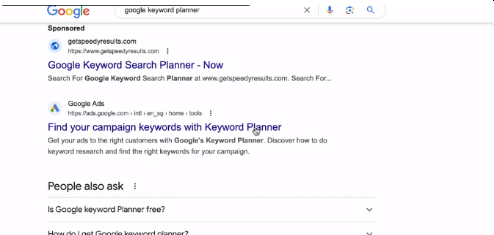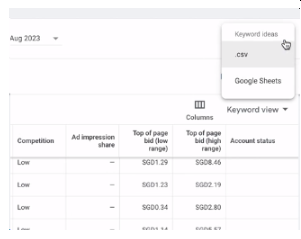In this lesson, I’m going to talk about using a tool called Google Keyword Planner or Keyword Ideation and I’m also, a little, gonna talk about keyword clustering and what it is.

So, without further ado, let’s get to generating keyword ideas. To use the Google Keyword Planner you need to have an active Google Account. The on Google, just search for “google keyword planner”.
Generating keyword ideas becomes easier when you use effective Keyword Research Tools to discover high-traffic and relevant search terms.

Select the “Find your campaign keywords”, the first non-sponsored result, Note the “https://ads.google.com” URL. And get into the tool.
If you have never used the keyword planner before for generating keyword ideas, you may need to create a Google Ads account by filling out some information. Now Google Ads is as place for businesses to pay and display their Ads on Google.
But, you don’t have to worry, you don’t need to run an Ad to use the keyword planner. It is free to use, click on “Explore Keyword Planner” and we’re in. Now that you’re directly on the Google Ads Account, to find a keyword planner, you need to select “Tools” from the left menu, and under the “Planning” section you will find “Keyword Planner”.
Let’s close the menu and focus on the Keyword Planner.
When generating keyword ideas, using an SEO Keyword Generator can help you find high-ranking and relevant search terms quickly.

There are two options for you. 1. Discover new Keywords and the other is to Get search volume and forecasts.
We’ll start with “Discover new keywords”. The first thing you need to do is add a seed keyword, and the trick is not to be specific, yet not too general. For example we’re in the niche of “home gym” we don’t want to be too general like “gym” and we don’t want to be too specific like “home gym exercise equipment for seniors with limited mobility”. Because if you try to get results we won’t get many ideas.
Table of Contents
ToggleGenerating Keyword Ideas
Make sure you remove any specific locations if the target audience for your blog is worldwide. So, the trick when adding a seed keyword is to be broad without being specific.
When doing keyword research, we will need to be mindful of the “Avg monthly searches” column which is the number of times this particular keyword has been searched for every month.
We don’t need to worry too much about the other columns, even the Competition because the competition column is for businesses to know how competitive a keyword is, if they were to spend money and bid for their Ads to be displayed on Google.
This is not an indicator for content creators to rank their content, organically, on Gooogle. Now, I want to introduce you to a term called “keyword clustering” in case you have not heard of it before. “Keyword Cluster” is a term used when we group multiple keywords, with the same meaning and search intent, together.
For example: “outdoor fitness equipment” and “outdoor exercise equipment” they, basically, mean the same thing and serve the same search intent. To confirm this do a search on both keywords and the search results will be very similar.
So, technically, keyword clustering allows you to asses keywords together as a group, instead of as a keyword individually.
Because sometimes, let me walk you through an example, let’s search for “best ecofriendly toilet paper” and, oh dear we only have 0 – 10 monthly volume. Most of the time, if we pick a keyword to target, we’re gonna pick a keyword with at least 100 search volume a month.
So, if we had assesed the keyword individually, we would have given up on it. However, if we just do a little tweak on the keyword, remove “best” would retain the search intention and we now have 100 – 1000 monthly search volume.
We can see better results if we add a space between “eco” and “friendly”, “eco friendly toilet roll” has the same meaning and search intent. “eco friendly toilet tissue” is the same.
If we cluster all these keywords with the same meaning and search intent, we can assess the combined search volume. Any, why do we group then together? It is because we will only write one article targetting all these keywords.
Generating keyword ideas is essential for finding the Best Keywords for SEO, ensuring higher rankings and increased website traffic.

Google Keyword Planner can help you cluster all relevant keywords. See the “Keyword View” list, change this to group view, if you are going to write an article about “gym essentials”, you can target all these keywords.
We can see that the “home gym essentials” keyword as a group has a very high search volume. You have the potential to rank for all these keywords if you optimize for them.
Generating keyword ideas is more effective when combined with Keyword Analysis Techniques to identify high-performing search terms.
Competitor Search
I want to share with you another thing, remember I said one of the best ways to find highly relevat keyword ideas is from your competitors and we have gone thhrough some good exercises. Now let me show you how you can get all the competitor keyword ideas from the keyword planner.
Keyword Research Tools are invaluable for generating keyword ideas, helping you uncover terms that drive traffic and improve SEO performance.

Go to Google to find a competitor, search for “best home gym”. You want to find a site that is a close competitor to you. You know they will be targetting many keywords you would be interested in. You know their business model is just like yours. Pick at site, copy the URL, head back to the Keyword Planner and “Discover new Keywords” click “Start with a Website” and paste the competitor URL. choose all locations and “Get Results”.
Unfortunately, competitor results don’t work in the group view, you have to select the keyword view, you will get all the keywords your competor is ranking for in Google.
This is even neater than going through the keyword ideation on Google Search.
Multiple Competitor Sites
Now, let’s do an exercise to get as many keywords from multiple competitors sites. We already have about 1500 keyword ideas from barbend.com. Let’s find two other sites. Copy the URL, go to a new keyword planner and paste in the URL. Repeat this for a third site.
Verifying search volume is an essential step in the fundamentals of content writing, as it helps create a targeted content outline that resonates with your audience.

Now, you want to download all these keywords as Google Sheets. Once saved, open the Google sheet and delete all columns except keyword and monthly searches. We can copy and paste this list to our Keyword Research Spreadsheet, but not yet. We want to get the keyword ideas from the other two sites.
Download each set as a Google sheet, copy and paste the results from the 2nd and 3rd companies to the 1st result sheet, we are likely to have many duplicated keywords. Select keyword column, go to “Data”, “Data Cleanup” and “Remove Duplicates”.
Now you have a huge list of keyword ideas, And the best part, you know all these keyword ideas have search volume. you just need to cluster then together.
Search Volume
Now, in the very fine search volume, it is all about finding the search volume for each keyword, but if you are using the Keyword Planner Method, you have already found the kewords with searh volume. So, the lesson on verifying search volume is more for you if you have done the manual keyword search methods.
If you don’t want to spend money on keyword research tools, the Google Keword Planner is a great tool to not only help you in generating keyword ideas but also a great way to find clusters, so that you don’t need to guess if you should create one article to target a keword and a seperate article to target another keyword. You can just create one article that targets all the keywords in the same cluster.




